Physical Address
304 North Cardinal St.
Dorchester Center, MA 02124
Physical Address
304 North Cardinal St.
Dorchester Center, MA 02124
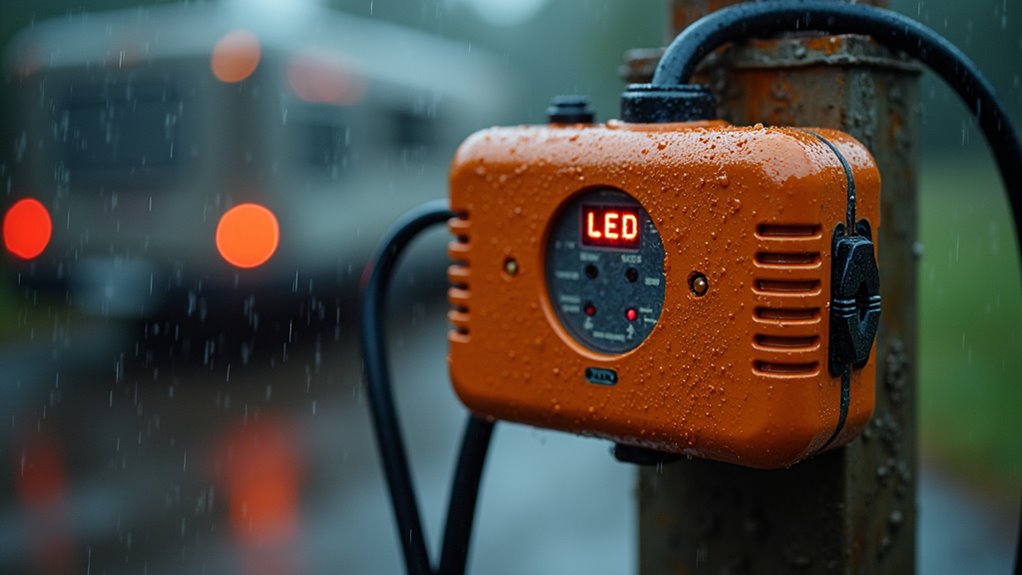
Grab essential tips about RV surge protector safety in wet conditions before your next camping trip turns into an electrical nightmare.
You might assume that your RV surge protector’s water-resistant rating means it’s completely safe in wet conditions, but that’s not entirely true. While many modern units can handle some moisture exposure, they’re not invincible against the elements. Understanding the real capabilities and limitations of your surge protector’s weather protection can mean the difference between safe electrical connections and dangerous malfunctions. Let’s explore what you need to know about keeping your RV’s electrical system protected in wet conditions.
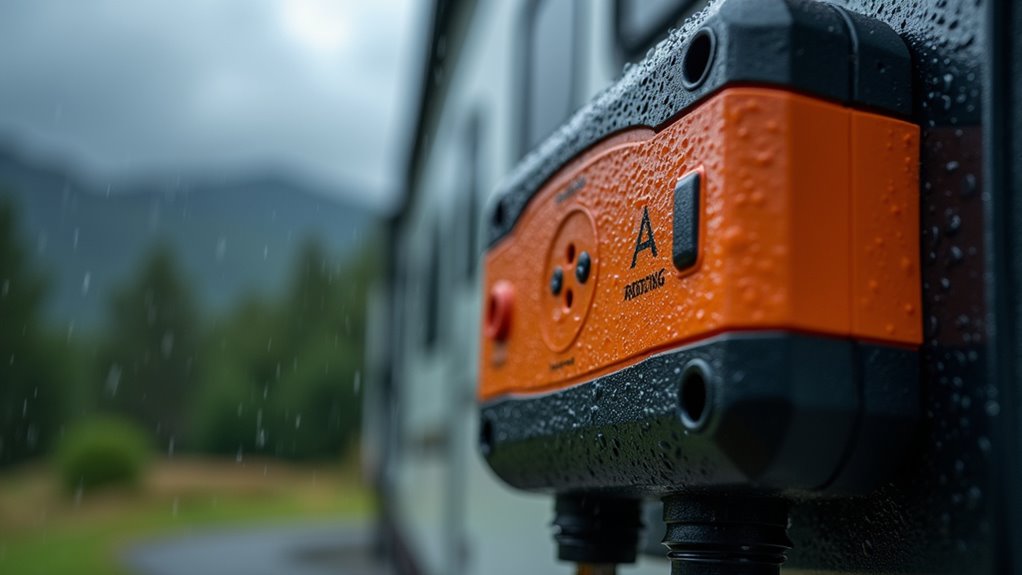
When choosing an RV surge protector for outdoor use, understanding water resistance ratings is essential for protecting your electrical equipment.
These ratings, known as IP (Ingress Protection) codes, use two numbers to indicate protection levels against solids and liquids.
You’ll find common ratings like IP65, which means the device is dust-tight and protected against water jets, or IP67, which can handle brief immersion.
For RV applications, you’ll typically want at least an IP65 rating to guarantee your surge protector can withstand rain and weather exposure.
Remember that higher IP numbers indicate better protection.
While many modern RV surge protectors include these ratings, some models don’t specify them.
When selecting a unit, look for clear IP rating information to guarantee you’re getting adequate protection for your outdoor power connections. Quality surge protectors with proper water resistance can help prevent costly electrical damage that often exceeds $3,000 in repairs.
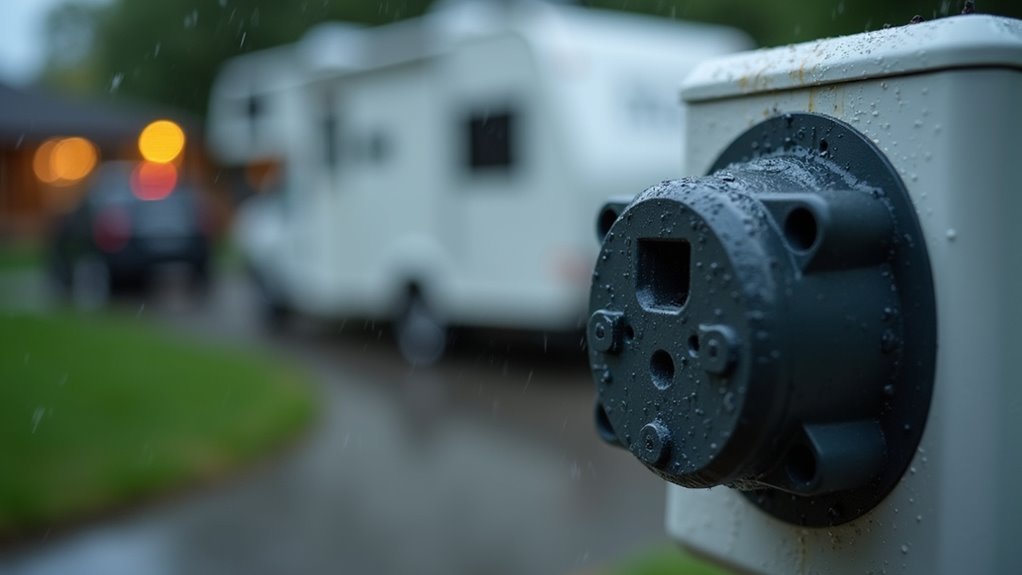
Modern RV surge protectors incorporate multiple layers of weather protection to safeguard your electrical system in harsh outdoor conditions.
You’ll find durable polycarbonate housings with weather-sealed enclosures that prevent moisture infiltration, while UV-resistant materials protect against sun damage. These features are especially crucial since lightning strikes commonly cause dangerous power surges.
Many units feature automatic shut-off mechanisms that activate during extreme weather, and advanced models include smart monitoring systems that’ll alert you to weather-related voltage changes.
You’ll also benefit from integrated thermal management systems that handle heat buildup during operation. The internal components, particularly Metal Oxide Varistors (MOVs), are designed to absorb voltage spikes while being protected from moisture exposure.
Look for surge protectors with high IP ratings (IP65 or better) and UL certification to guarantee you’re getting reliable weather protection for your RV’s electrical system.
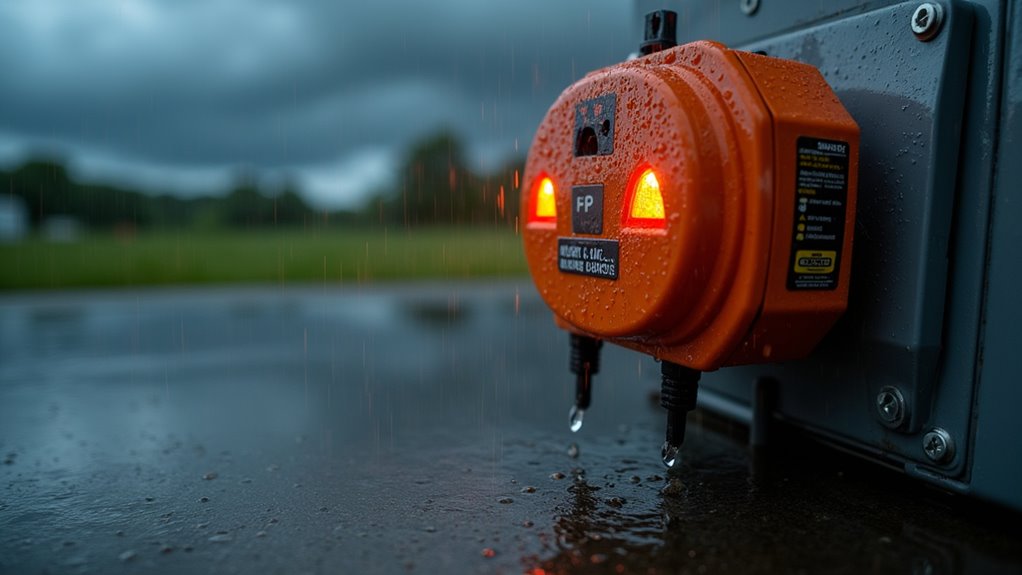
The serious dangers of water exposure to electrical equipment extend far beyond immediate short circuits and power failures.
When water penetrates your electrical devices, it triggers corrosion of metal components and degrades essential insulation materials. This damage continues even after the equipment appears dry.
You’ll face multiple risks if you use water-damaged electrical equipment. Corroded contacts in switches and breakers won’t provide proper protection, while compromised insulation can lead to dangerous electrical shorts. According to safety guidelines, qualified electrical professionals must assess water-damaged equipment before use.
If your device was exposed to flood or salt water, it’s even worse – these contain chemicals and debris that accelerate deterioration and create hidden hazards.
Don’t assume drying equipment makes it safe to use. Water exposure can cause unpredictable failures and fire risks that aren’t visible.
Always have a qualified electrician evaluate water-damaged electrical devices, as many components will require replacement.
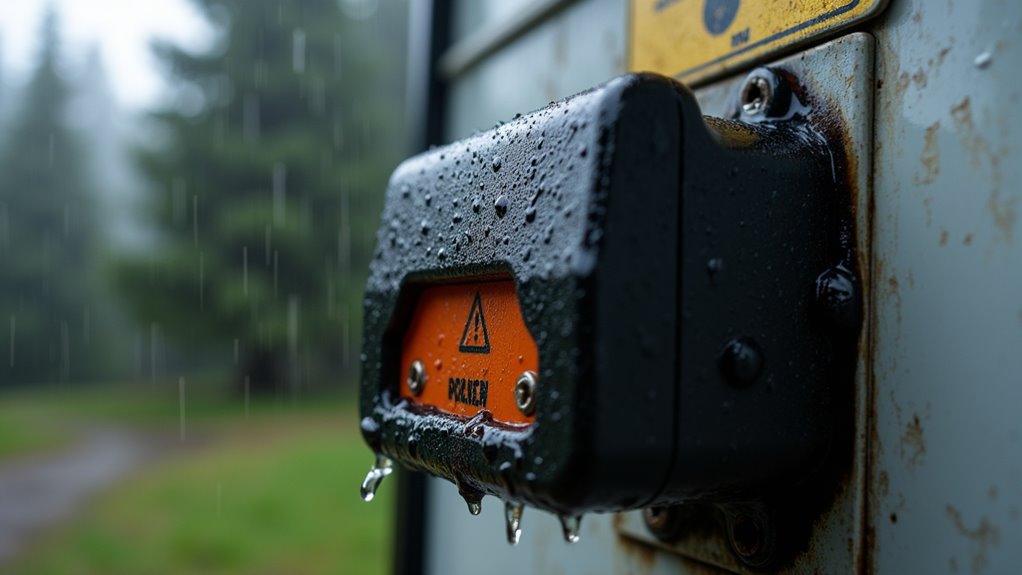
Using RV surge protectors safely in rainy conditions requires specific precautions to protect both your equipment and yourself. While many surge protectors are weather-resistant, you’ll need to guarantee proper placement and monitoring during wet conditions.
First, mount your surge protector securely above ground level and away from standing water. Don’t rely solely on weather resistance – use additional protection like weatherproof casings when possible. The emergency power off feature will automatically disconnect power if water infiltration is detected, providing an extra layer of safety.
Keep an eye on the LCD or LED displays for any moisture-related warnings, and disconnect power immediately if you notice any issues.
Remember to perform regular checks after rain exposure, and store portable units in dry locations when not in use.
If your surge protector shows signs of water damage or malfunction, don’t attempt repairs yourself – have it professionally inspected to guarantee safe operation.
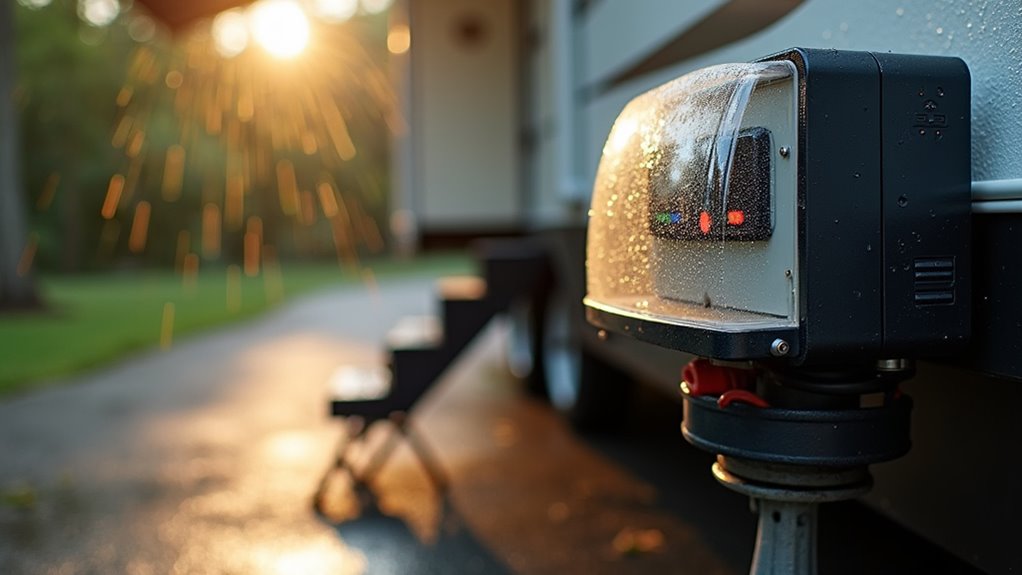
Beyond protecting your surge protector from rain, proper outdoor installation and placement can considerably extend its lifespan and effectiveness.
Position your surge protector in sheltered areas, such as under canopies or in protected corners, while keeping it easily accessible for maintenance. Installing portable surge protectors directly at the power pedestal offers the most immediate protection for your RV’s electrical system. You’ll want to mount it close to the power source using weather-resistant materials and waterproof enclosures.
Ensure all connections are secure and use waterproof electrical connectors to prevent moisture infiltration. Keep your cables organized and protected from environmental damage.
Don’t forget to follow the manufacturer’s guidelines for installation and regularly inspect the unit for signs of wear. Remember to comply with RV park regulations and electrical safety standards when choosing your placement location.
Regular testing with a multimeter will help confirm your surge protector is functioning properly.
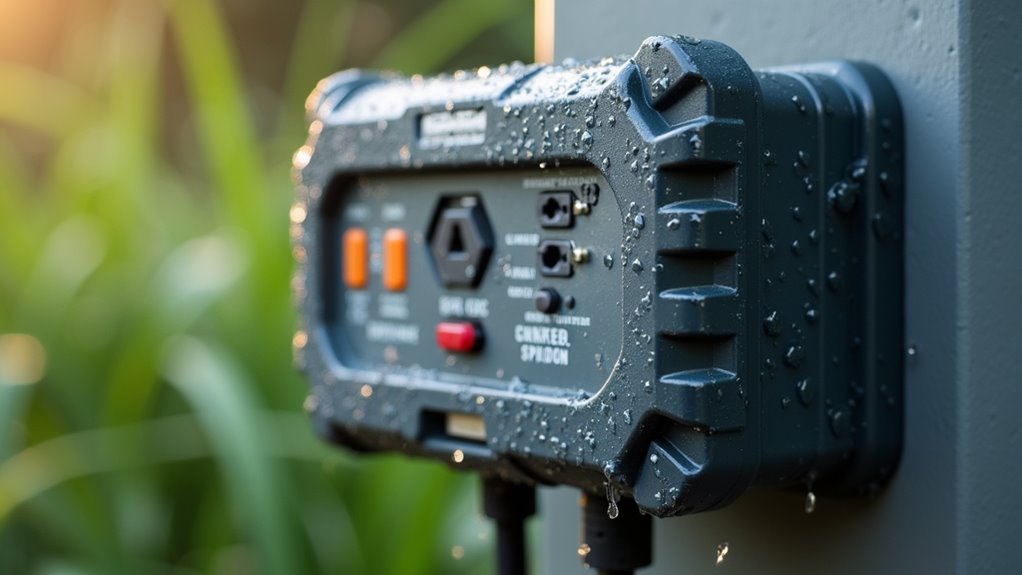
Weather-resistant casings serve as the first line of defense for your RV surge protector’s internal components. The durable plastics, including fire-retardant ABS and PVC insulation, protect essential electrical parts from moisture, debris, and temperature fluctuations.
These protective housings are engineered to be leakproof, preventing water from reaching sensitive circuits and components that could short-circuit or corrode. The water-resistant cover provides an additional shield against harsh outdoor elements.
You’ll find that internal surge suppression elements, circuit analyzers, and LED indicators remain fully operational thanks to the sealed design. The casing’s weather-resistant properties don’t compromise the surge protector’s performance – it’ll still respond instantly to power surges while maintaining its rated protection levels of up to 45,000 amps.
With proper sealing mechanisms and protective covers, you won’t need to worry about water-related electrical failures or frequent maintenance due to weather exposure.
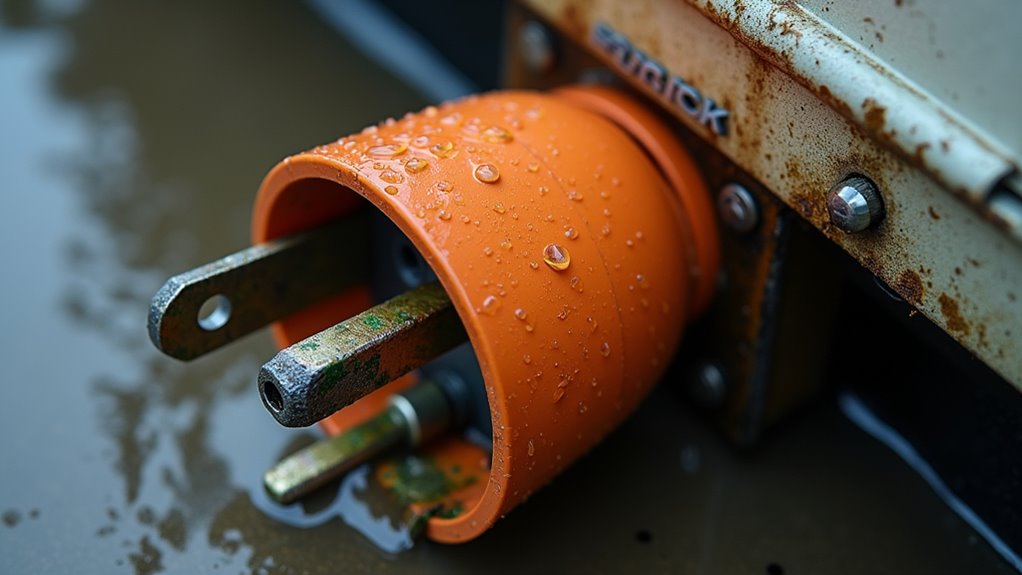
Several key warning signs can alert you to water damage in your RV surge protector.
Watch for electrical performance issues like power cutoffs, AC unit failures, and flickering lights. Regular surge guard maintenance helps prevent costly water damage to your RV’s electrical system. You’ll also want to look for visible indicators such as swollen plastics, water spots, rust, or discoloration on the casing.
Pay attention to any bulging seals or corrosion on metal components, as these often signal water exposure. If you notice erratic power delivery or experience electrical shocks, disconnect the device immediately.
Water damage can severely impact sensitive components like MOVs and circuit boards, leading to costly repairs.
Don’t forget to inspect your surge protector regularly, especially after rain or high humidity conditions.
When in doubt, it’s safer to have a professional assess any suspected water damage.
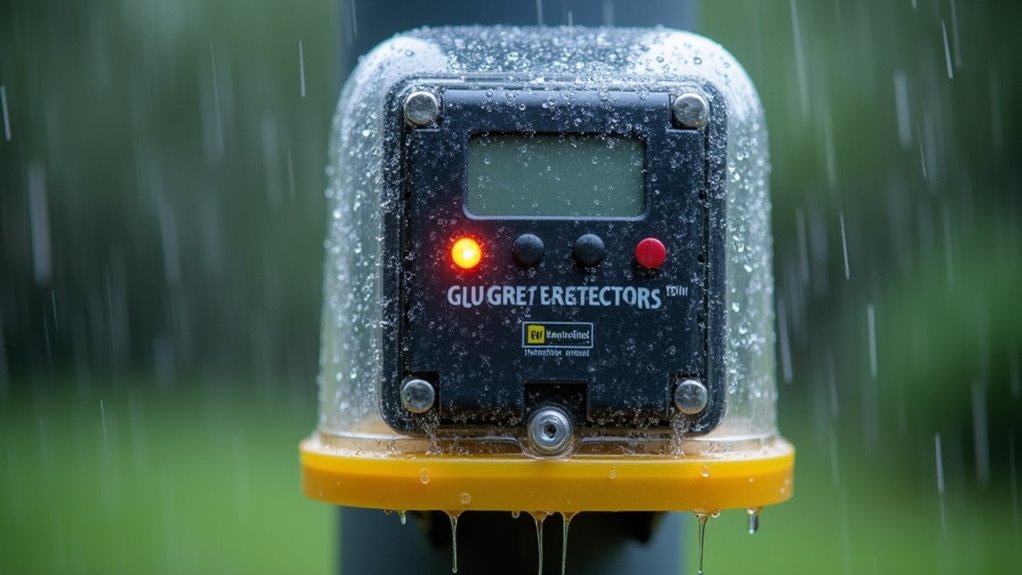
To maximize your RV surge protector’s weather resilience, you’ll need multiple layers of protection against extreme conditions.
Start by mounting your unit on elevated surfaces using dedicated brackets to prevent ground moisture contact. Install a weatherproof locking box or secure enclosure that shields against rain while preventing theft.
Position your surge protector under your RV’s awning whenever possible, and use weather-rated extension cables with watertight seals for connections. Today’s surge protectors can handle temperatures from -31° to 212° F.
For permanent solutions, consider upgrading to a hardwired surge protector that integrates directly with your RV’s electrical system, eliminating exposed outdoor connections entirely.
Don’t rely on waterproof bags, as they can trap moisture and cause overheating. Keep a backup portable unit ready for emergencies, and always monitor weather forecasts to take preventive action before storms arrive.
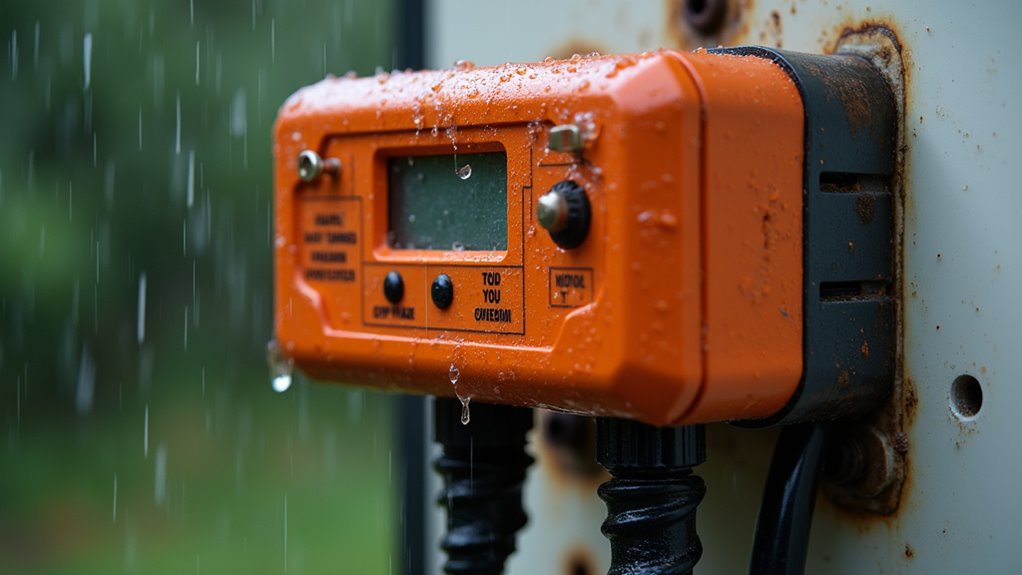
Maintaining your RV’s surge protector requires regular attention to confirm its weather-resistant capabilities stay effective. Start by inspecting your device monthly for signs of wear or damage, especially after exposure to harsh weather conditions.
Position your surge protector vertically to prevent water infiltration, and clean it regularly with a soft cloth and mild detergent. Thanks to its IP65 water resistance, your Power Watchdog surge protector is built to withstand dust and rain exposure during outdoor use.
Don’t forget to check the LED indicators to verify they’re working correctly, as they provide essential diagnostic information about your device’s status.
Monitor the unit’s exposure to environmental factors – keep it away from direct sunlight and confirm it operates within specified temperature ranges.
When installing, verify proper grounding and secure all connections. If you notice any damage to the wiring, plugs, or sockets, address these issues immediately to maintain the surge protector’s integrity and safety features.
Having a camping checklist handy ensures you don’t overlook critical maintenance tasks during your RV adventures.
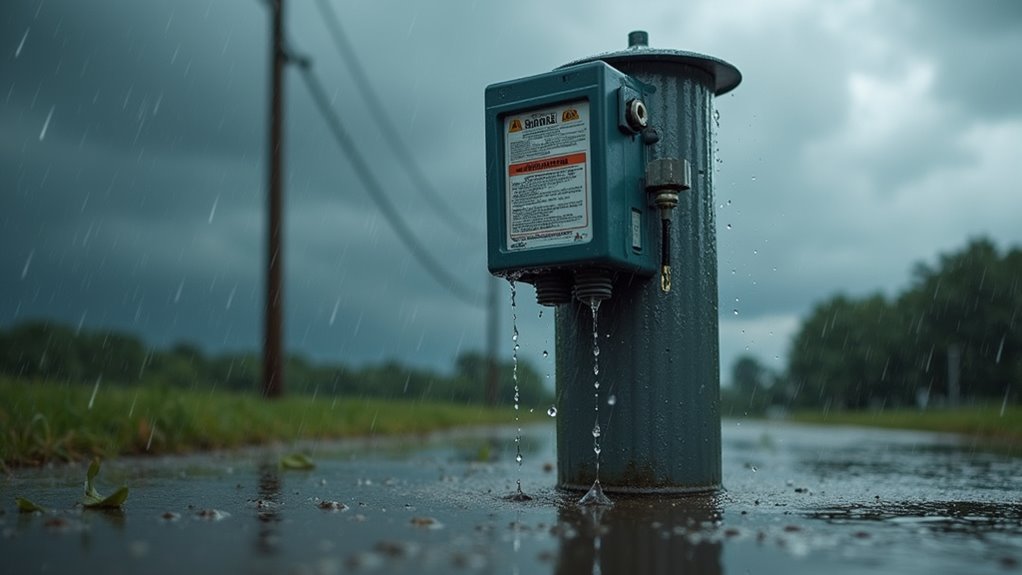
Proper storage and transportation of your RV surge protector directly impacts its longevity and performance.
Store your device in a dry, climate-controlled location away from direct sunlight, and elevate it on a shelf to prevent water damage. You’ll want to place it in a protective bag or container for extra moisture protection. Since EMS surge protectors offer the most comprehensive protection, they especially need proper storage care.
When transporting your surge protector, secure it in a padded, weather-resistant case with foam padding to prevent impact damage.
Keep all cables disconnected, cleaned, and stored separately to avoid connector stress. Don’t forget to coil them properly using cable organizers.
For long-term storage, disconnect all electrical connections, remove any batteries, and follow manufacturer guidelines.
Store in an area with stable temperature and humidity, and check periodically for moisture or damage signs.
Your RV surge protector can handle some moisture, but you shouldn’t risk unnecessary exposure. While modern units feature weather-resistant designs, water remains a significant threat to electrical equipment. Always mount your surge protector in a sheltered spot, use weatherproof covers, and check regularly for damage. Remember, prevention is cheaper than replacement – protecting your surge protector from water guarantees it’ll keep protecting your RV’s electrical system.